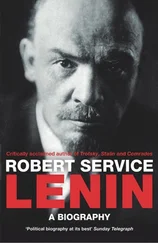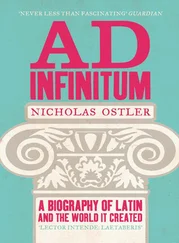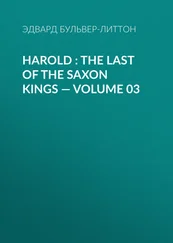Lenin’s paternal lineage was plainly plebeian, and the ‘Biographical Chronicle’ makes much of the fact that his grandfather had been a serf. But this was not actually true. Lenin’s grandfather, Nikolai Vasilievich, was a Russian town-dweller 12 of Astrakhan who earned his living as a tailor. He was the son of a serf, but at an early age had been released to work away from the village, and had never returned home, becoming a town-dweller – as distinct from a peasant, merchant or nobleman – by social status. It was Lenin’s great-grandfather, Vasili Nikitich Ulyanov, who had been a serf. 13 He had remained single until he turned fifty, and it was only then, having saved up some money, that he married. His bride, who was almost twenty years his junior, was Anna Alexeevna Smirnova, a baptized Kalmyk, whose ethnic origin was responsible for Lenin’s somewhat Asiatic appearance. Five children resulted from this late marriage: Alexander, Vasili, Ilya (Lenin’s father), Maria and Feodosia. Ilya was the youngest child, and was born when his father was already past sixty and his mother was forty-three. His father died in 1836, leaving his wife, the five-year-old Ilya (Alexander had died in infancy), and his two daughters to his seventeen-year-old son, Vasili, to look after.
Vasili rose to the occasion and displayed exemplary enterprise, becoming a salesman for Sapozhnikov Brothers, a large commercial firm in Astrakhan. His willingness to work and his loyalty earned his employers’ trust, and he was able to look after his mother and younger brother, supporting Ilya through his studies at Kazan University until he became a teacher of mathematics, sending him money ‘for settling down’, ‘for the wedding’, ‘for the move’ and so on. Vasili, a bachelor all his life, and a diligent and enthusiastic salesman, may also have sent his cash assets to Ilya shortly before he died at a date historians have been unable to establish. 14
It would not be worth dwelling on the Ulyanov family tree had the official picture not been so obscured by a mass of unnecessary trivia and painted in the colours of ‘class consciousness’, and had so much not been passed over in silence, distorted and blatantly falsified. A brief account, however, may suffice to show that Lenin’s background reflected the face of the entire empire. He had a general idea about his origins, but, although he was Russian by culture and language, his country was not his highest value – not that he particularly felt himself to be a German, a Swede, a Jew or a Kalmyk. He may have described himself as a Russian when filling in forms, but in his outlook he was an internationalist and cosmopolitan, for whom the revolution, power and the Party were to be immeasurably more precious than Russia itself. It is only important to clarify this matter because the Bolsheviks found it necessary to suppress evidence of the perfectly natural mixture of nationalities in Russia in order to present their leader as ethnically ‘pure’.
Lenin’s antecedents were Russian, Kalmyk, Jewish, German and Swedish, and possibly others, symbolizing Russian history, as it were: a Slavic beginning, Asiatic expansion, a Jewish accretion to the national intellect, and German or West European culture. Genetic selection in history is spontaneous and mysterious. But here a digression is called for. When Lenin died, the Central Committee Secretariat commissioned his elder sister, Anna Yelizarova, to collect all the materials she could find and to write a definitive account of the Ulyanovs. Anna, who was one of the founders of the Lenin Institute, set to work, and soon discovered what I also found: namely, that there was a mass of material in the St Petersburg police department archives about her mother’s descent, as well as other materials which M.S. Olminsky, chairman of the Commission for the Study of the History of the Party ( Istpart ), helped her locate. Some eight years later she had still not divulged her discoveries to anyone. But in 1932, two years before she died, she suddenly revealed her findings to Stalin, and said she wanted to publish them. She knew that her great-grandfather, Moishe Itskovich Blank, had been born in Starokonstantinov, that his two sons, Abel and Srul, had converted to Christianity and changed their names to Dmitri and Alexander, and that in 1820 both had been admitted into the St Petersburg Medical-Surgical Academy, from which they graduated in 1824. 15
In her letter to Stalin, Anna wrote: ‘It’s probably no secret for you that the research on our grandfather shows that he came from a poor Jewish family, that he was, as his baptismal certificate says, the son of “Zhitomir meshchanin Moishe Blank”.’ She went on to suggest that ‘this fact could serve to help combat anti-semitism’. Paradoxically for a Marxist who believed in the primacy of environmental over inherited factors, she also asserted the dubious proposition that Lenin’s Jewish origins ‘are further confirmation of the exceptional abilities of the Semitic tribe, [confirmation] always shared by Ilyich [Lenin] … Ilyich always valued the Jews highly.’ 16 Anna’s claim explains, for instance, why Lenin frequently recommended giving foreigners, especially Jews, intellectually demanding tasks, and leaving the elementary work to the ‘Russian fools’. 17 According to General A.A. Yepishev, former chief of the army’s main political directorate, who heard it from Stalin’s personal assistant Poskrebyshev, Anna’s sister Maria handed the letter to Stalin and waited while he read it carefully. His response was categorical and fierce: ‘Absolutely not one word about this letter!’ But a little over a year later, Anna approached Stalin again, asserting that ‘in the Lenin Institute, as well as in the Institute of the Brain … they have long recognized the great gifts of this nation and the extremely beneficial effects of its blood on the progeny of mixed marriages. Ilyich himself rated their revolutionary qualities highly, their “tenacity” in the struggle, as he put it, contrasting it with the more sluggish and unstable character of the Russians. He often pointed out that the great [attributes of] organization and the strength of the revolutionary bodies in the south and west [of Russia] arose precisely from the fact that 50 per cent of their members were of that nationality.’ 18 But Stalin, the Russified Georgian, could not allow it to be known that Lenin had Jewish roots, and his strict prohibition remained firmly in place.
In November 1937, the writer Marietta Shaginyan published an article in the Moscow journal Novy mir as the first part of her research into the genealogy of the Ulyanovs. Somehow the article went unnoticed, but in 1938 she published her work as a novel based on fact, entitled The Ulyanov Family , and dealing with the origins of the family up to the birth of Lenin. The reaction was harsh. The book was first read by a small group of senior members of the Soviet Writers’ Union, who condemned it as an ‘ideologically dangerous’ work of’petty bourgeois’ character. A month later, on 9 August 1938, the presidium of the Union convened and passed a resolution which declared that ‘in applying pseudo-scientific research methods to Lenin’s so-called “family tree”, M.S. Shaginyan gives a distorted representation of the national character of Lenin, the greatest proletarian revolutionary, a genius of mankind, who was raised up by the Russian people and who is its national pride’. 19 Those responsible for writing, publishing and distributing the book were dealt with severely. In 1972, all documents on Lenin’s origins, 284 pages in all, were transferred from the various archives which held them to the Central Committee special collections, where they remained.
The German branch of Lenin’s family tree is also interesting. According to Leonhard Haas, the Swiss historian and former director of the Swiss Federal Archives, the Groschopfs, all of whom were wealthy bourgeois, came from northern Germany and could boast several notable personalities throughout German history: Lenin’s great-grandfather, J.G. Groschopf, was a representative of Schade, a German trading company. Other ancestors and descendants of Lenin’s forebears include I. Hoeffer, a well-known theologian; Ernst Curtius, the tutor of Kaiser Friedrich III; and Field Marshal Walter Model, who earned the title of ‘the Führer’s Fireman’ as an audacious commander in the Wehrmacht’s assault on Moscow in 1941. 20 The Swedish branch, who were mostly artisans – wigmakers, hatters, tailors – issued from a rich jeweller, one K.F. Estedt, who lived in Uppsala and supplied the court of King Gustavus IV in the late eighteenth century.
Читать дальше












